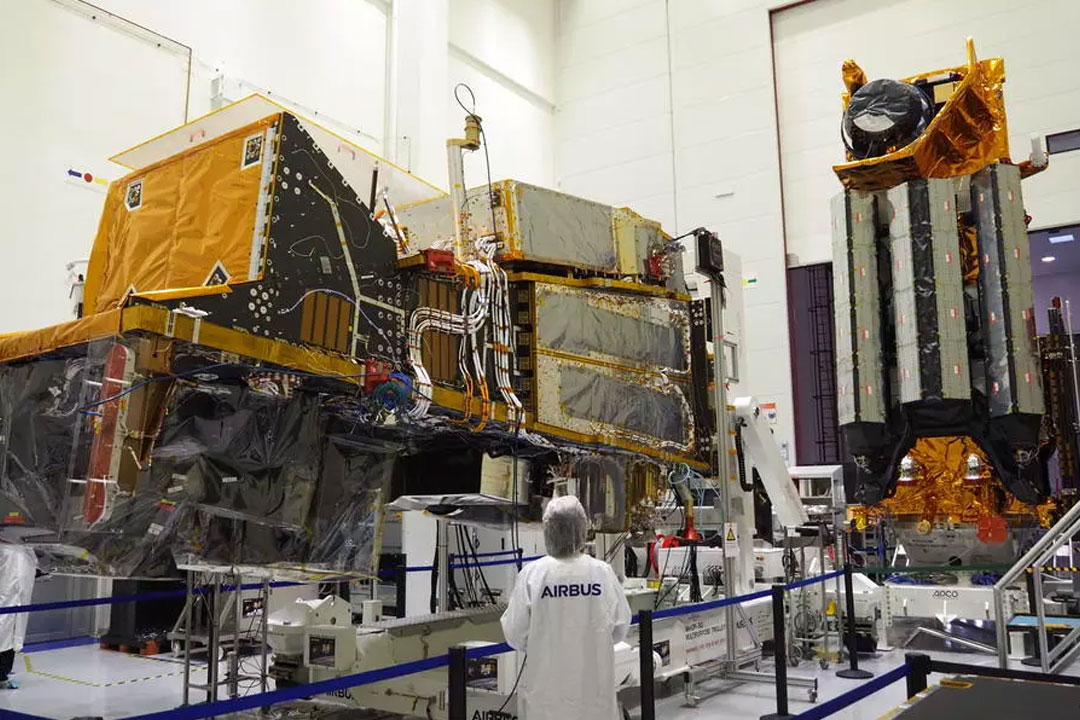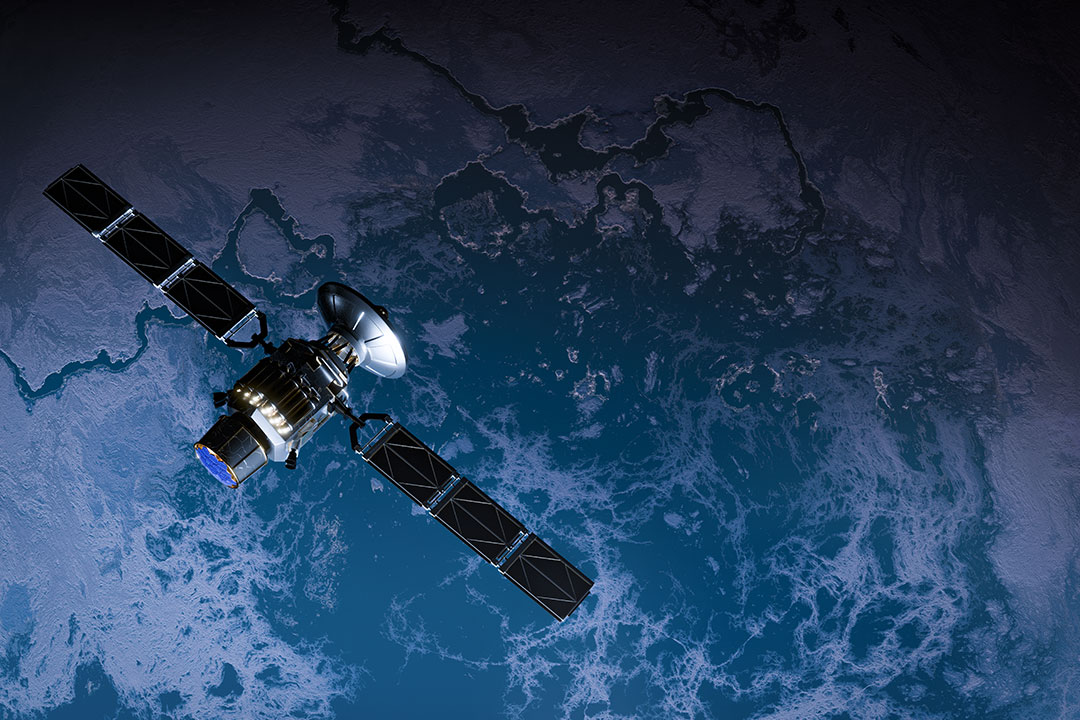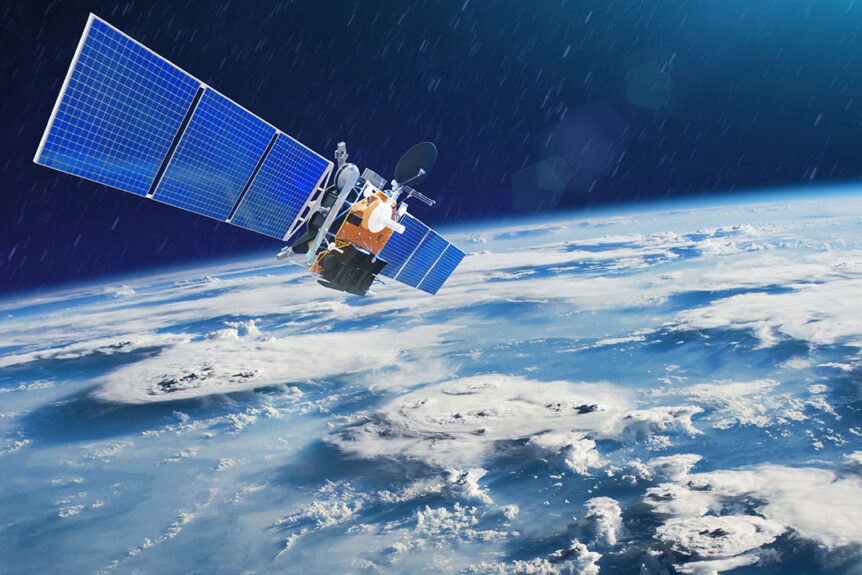A transformative shift in weather forecasting is underway, driven by aerospace innovation. Airbus is at the forefront of this change, leveraging advanced satellites, sophisticated sensors, and artificial intelligence to dramatically improve the accuracy and reliability of our weather predictions.
Advancing Meteorology Through Next Generation Satellites
A cornerstone of this new era is the MetOp Second Generation (MetOp SG) satellite program, led by Airbus in collaboration with ESA and EUMETSAT. The first in the series, MetOp SG A1, was successfully launched in August 2025 and is entering its commissioning phase.
These satellites are intended to succeed the current MetOp fleet, ensuring continuity and improvement of global meteorological observation into the mid 2040s. Airbus builds the “A” series in Toulouse and the “B” series in Friedrichshafen.

MetOp-SG A and B at Airbus’ facilities in Toulouse | Photo: airbus.com
Onboard MetOp SG A1, a suite of advanced instruments, including IASI NG (Infrared Atmospheric Sounding Interferometer Next Generation), METimage, a Microwave Sounder, a Radio Occultation Sounder, and a Multi-view, Multi-channel, Multi-polarisation Imager, gather high resolution data on atmospheric temperature, moisture, cloud structure, aerosols, and trace gases. The satellite also carries the Copernicus Sentinel 5 instrument for monitoring atmospheric composition.
With IASI NG offering approximately four times the precision of its predecessor, the payload adds critical vertical profiling of temperature, water vapor, and greenhouse gases, data essential for refining weather models and climate research alike.
How Airbus Contributes to Enhanced Weather Prediction
By engineering and deploying state of the art satellites, Airbus directly supports the infusion of richer, higher fidelity data into numerical weather prediction (NWP) systems. These inputs help reduce uncertainty, especially in forecasting clouds, aerosols, and subtle atmospheric motions.
NASA, NOAA, ECMWF, and others increasingly explore AI and data driven forecasting to complement classical physics based NWP models. For example, ECMWF’s new AIFS system uses graph neural networks and transformers to fuse observational data with model output, enhancing forecast quality for upper air and surface variables. Airbus’s improved data streams feed precisely into such hybrid modeling frameworks.
Elsewhere in aviation, Airbus also supports advanced onboard weather radar systems. The company works with radar suppliers to refine features like Doppler turbulence detection, hail and lightning prediction, and optimized display modes, allowing crews to better interpret and respond to oncoming weather. These enhancements reduce pilot workload while improving tactical weather avoidance.
Bridging Earth and Space: Space Weather Monitoring

A weather satellites in space.
Weather prediction is not confined to Earth’s atmosphere. Airbus is contributing to the next frontier: space weather forecasting. The Vigil satellite, being developed by Airbus Defence and Space, will be located at the L5 Lagrange point to monitor solar activity, such as solar flares and coronal mass ejections, before they impact Earth. Such early detection helps protect satellite systems, communications, navigation, and power grids from geomagnetic disruption.
Benefits and Applications of Predicting Weather More Accurately
- Disaster preparedness and public safety: Improved forecast lead time and accuracy enable emergency services to respond proactively to storms, floods, heatwaves, and other hazards.
- Aviation safety and efficiency: Airlines and air traffic control can optimize flight plans, avoid turbulence, and reduce fuel burn and delays.
- Agriculture and water management: Irrigation scheduling, crop protection, and flood control rely heavily on trustable forecasts.
- Climate research and environmental tracking: Long term, consistent data records aid in understanding climate change, emissions, and anthropogenic effects.
- Infrastructure resilience: Power grids, coastal defenses, and transport networks can better adapt to extreme weather when forecasts are more trustworthy.
Challenges and the Road Ahead
Even with advanced sensors, weather prediction remains inherently challenging. Small scale phenomena, such as microbursts, localized convection, and sudden turbulence, are harder to capture because they evolve rapidly and often fall below current spatial or temporal resolution thresholds. Data gaps exist over oceans and remote regions, making satellite coverage essential but not always sufficient. Also, integrating new satellite data streams with legacy forecasting systems requires careful calibration and quality assurance.

A massive super typhoon pictured from space.
Another obstacle lies in computing, ingesting huge volumes of high resolution data and running complex hybrid models demands enormous processing power and smart algorithms. But advances in machine learning, cloud computing, and high performance computing (HPC) help address this. The emergence of models like AIFS offers a glimpse of how future forecasting may operate.
Over the coming years, the launch of additional MetOp SG satellites, and further refinement of algorithms, is expected to steadily raise confidence in both short term and medium range forecasts. The synergy between aerospace engineering, climate science, and artificial intelligence positions Airbus and its partners as central players in ushering in a new era of predicting the weather, one in which forecasts are not only more accurate, but more actionable and timely.

